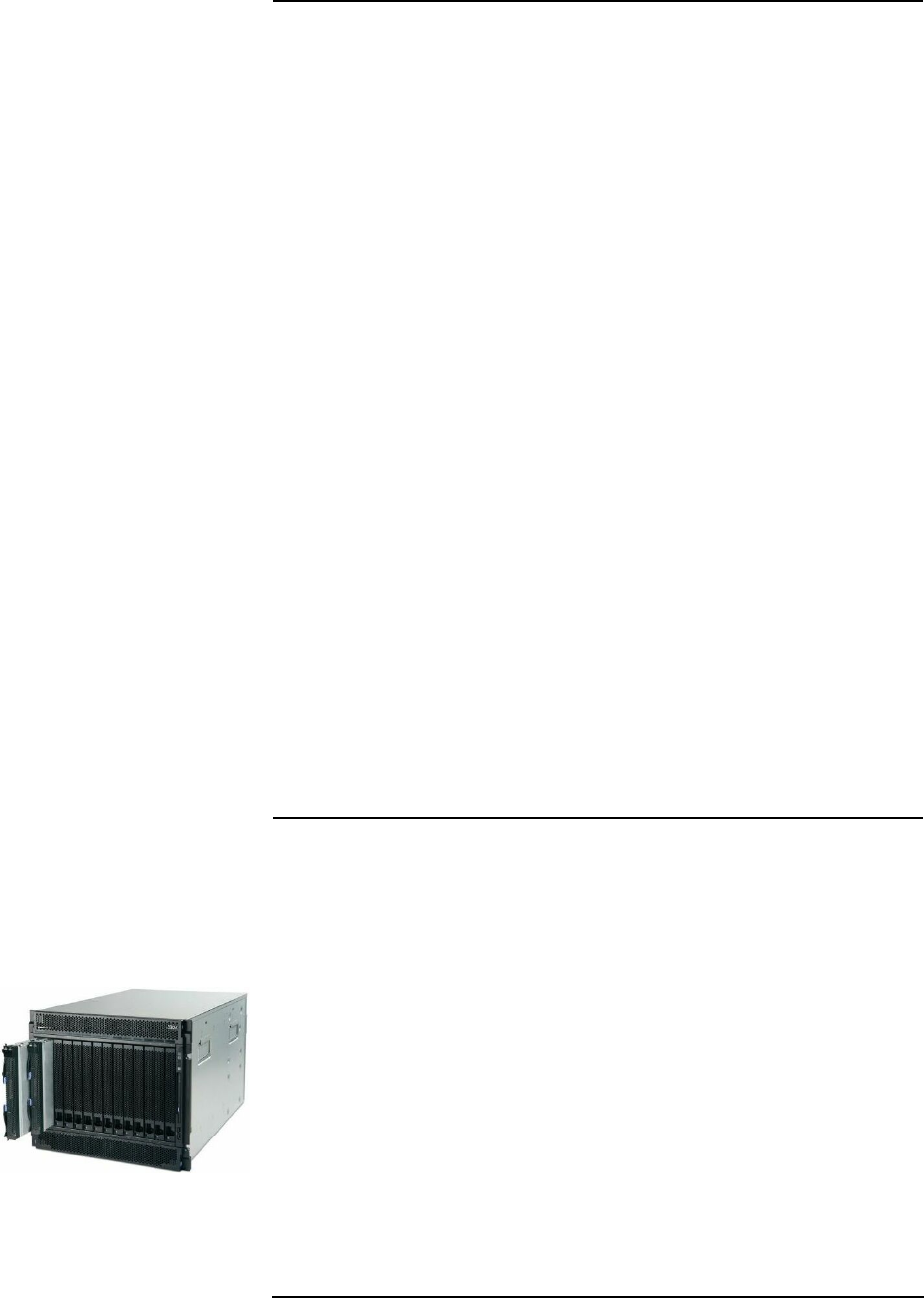
come standard with the chassis. They are capable of providing efficient cooling for up to 14
blades. These modules replace the need for each blade to contain its own fans. The two
blowers are more energy efficient than dozens or hundreds of smaller fans would be, and
they offer many fewer points of potential failure.
• Four module bays for Power Modules — BladeCenter E ships with two 2000W high-
efficiency hot-swap/redundant power modules (upgradeable to four), capable of
handling the power needs of the entire chassis. Many servers use power supplies with an
efficiency level of approximately 65-75%. Because BladeCenter E uses power supplies
that are at least 90% efficient, much less power is wasted as heat. Not only is more power
available for chassis use, there is less power wasted as excess heat output. Two
additional power modules must be installed when more than 6 blades are used in a
chassis.
• Redundant midplane connections — Each chassis contains a midplane that connects
all blades and modules together internally. The midplane provides two physical
connections to each blade; therefore, a failure of one connector alone cannot bring down
the server.
• A hot-swappable Media Tray containing a DVD-ROM drive, a floppy drive, one USB
1.1 port, and a light path diagnostic panel — The media tray is shared by all the blades
in the server. This eliminates unnecessary parts (and reduces the number of parts than
can fail). In the event of a failure of the Media Tray the tray can be swapped for another.
While the tray is offline, the servers in the chassis can remotely access the Media Tray in
another chassis. The diagnostic panel contains LEDs that indicate chassis status.
• IBM Airborne Contaminant Filter, which helps protect the blade server’s vital
components in non-data center environments.
It is extremely important to include all infrastructure costs when comparing a
BladeCenter E solution to a competitor’s offering, not just the cost of the chassis and the
blades. The high density and level of integration of the BladeCenter chassis greatly
reduces the cost of the overall solution. For example, because up to six chassis will fit in
a rack, this means that up to 84 blade servers/processors can be installed. (Some
competitive blade offerings would require a second rack for this many blades.) Also,
because up to four Ethernet, Myrinet, Fibre Channel, InfiniBand or other switches can be
installed per chassis, up to 24 switches can be installed per rack without having to
reserve any “U” space for the switches, unlike the competition. (And the integrated
switches may be less expensive than external, self-powered switches.) Plus,
the number
of power distribution units (PDUs) needed per rack may be reduced, because there
are fewer discrete devices to have to plug in. In addition, because all the blades are
connected to all the switches inside the chassis, there is no need for external Ethernet
or other communication cables to connect the blades and switches. (Only the few
cables needed to connect the switches to the external world are required.) This not only
saves the cost of numerous cables per rack, but also the clutter and bother of routing that
many cables. An added bonus is potentially much freer airflow behind the rack, due to
fewer cables.
BladeCenter H is a high-performance 9U chassis, designed for compute-intensive
environments, such as Earth/Life Sciences, commercial analytics and next-generation
network (NGN) applications. Think of it as BladeCenter E’s big brother, with more speed
and more features. It provides:
• Reduced single points of failure — Many major components (either standard or
optionally) are hot-swappable and/or redundant. Servers and modules can be
configured for automatic failover to backups.
• Forward and backward compatibility — Every blade, switch, and passthru module
released by IBM for the original BladeCenter E chassis since 2002 is supported in the
BladeCenter H chassis.
• High-speed redundant midplane connections — Based on 4X InfiniBand, the
midplane supports up to 40Gb bandwidth and provides four 10Gb data channels to each
blade. By giving each blade two physical connections to the midplane that connects all
blades and modules together internally, a failure of one connector alone cannot bring
down the server.
• Fourteen 30mm blade slots — These hot-swap slots are capable of supporting any
combination of 14 HC10/HS12/HS20/HS21/HS21 XM, LS20/LS21, JS20/JS21/JS22, and
QS21/QS22 (Cell/B.E), or 7 double-wide (60mm) HS40 or LS41 blade servers, or a
mixture of 30mm and 60mm blades. It also supports multiple optional 30mm Expansion
Units in combination with the blade servers, using the same blade slots. Up to four
chassis can be installed in an industry-standard 42U rack, for a total of up to 56 30mm
blade servers per rack.
• Up to ten module bays for communication and I/O switches or bridges — The
Please see the Legal Information section for important notices and information.
11.


















